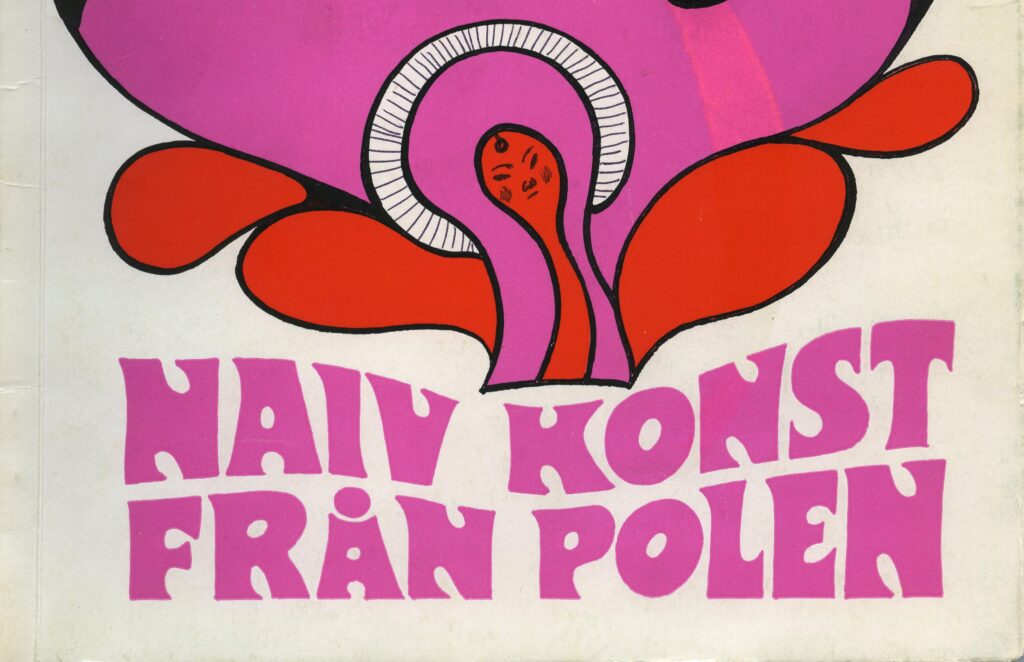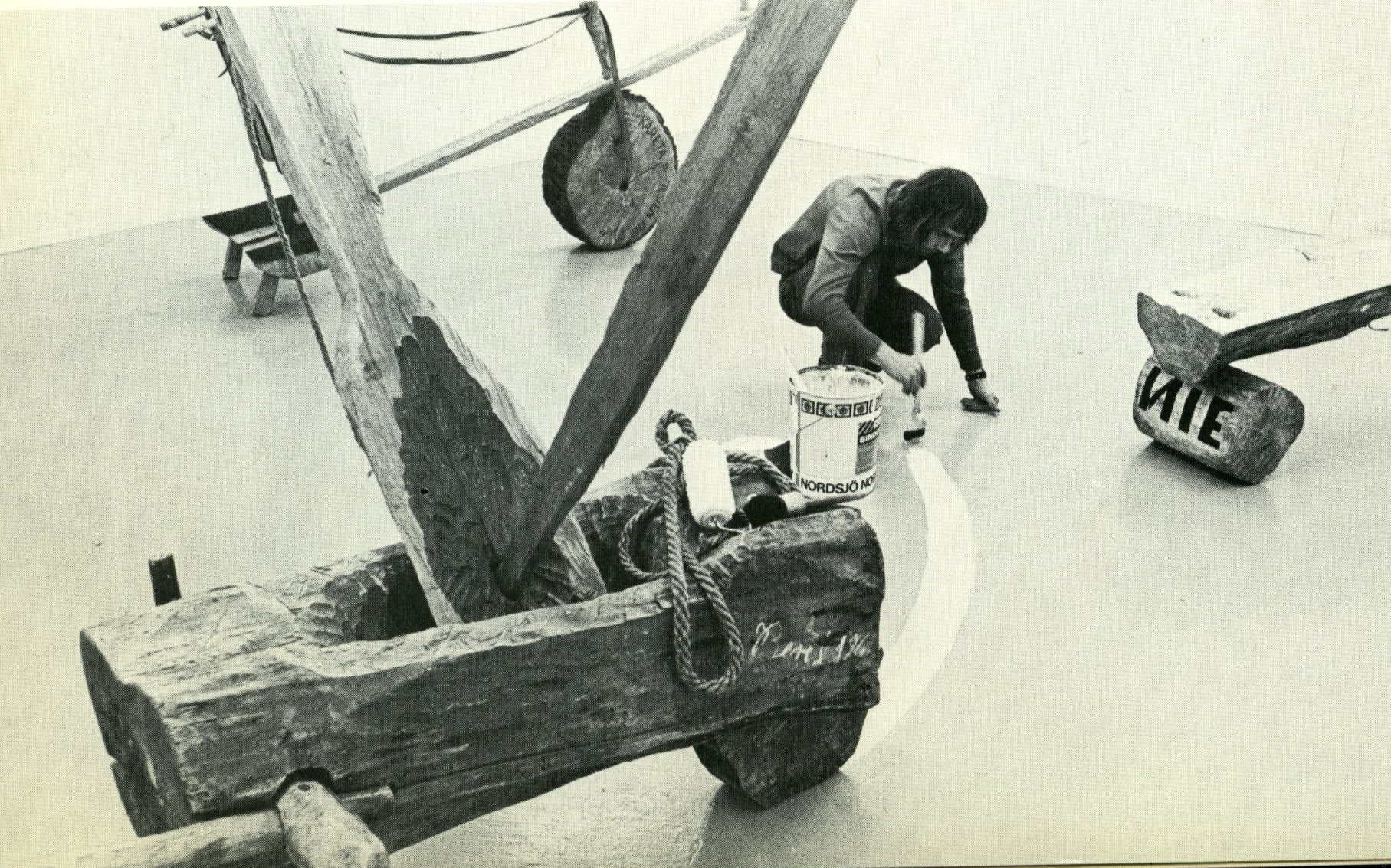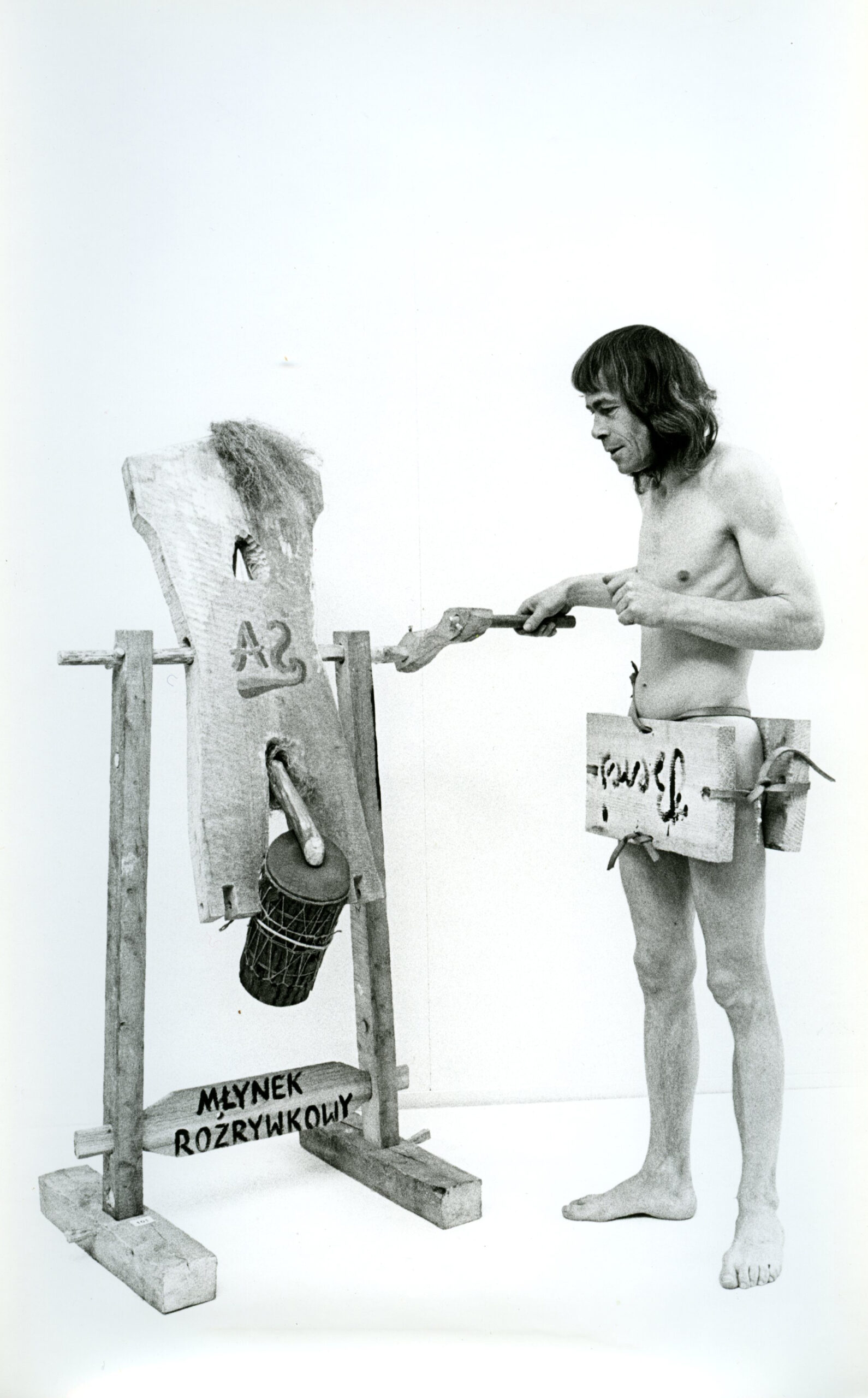


To build this exhibition, a slight panic arose in the weeks before the opening. It was necessary for the two artists to build the exhibition on site in the former Södertälje konsthall on Järnagatan in Södertälje. Jerzy Bereś did not have his visa to travel to Sweden and sent a telegram to Södertälje konsthall for help in speeding up the process. After a couple of phone calls, it was hoped that his journey from Kraków in Poland, where he then lived, to Södertälje was underway. The exhibition with his sculptures would otherwise not have been possible as only Bereś himself was the one who could assemble it, explains the art gallery’s assistant professor Ingvar Claeson in the exhibition catalog. Bereś describes “I create my works from natural materials such as wood, stone, bast but I do not treat them strictly. I use simple tools such as ax, saw, chisel, hammer, etc.… As the term sculpture did not seem satisfactory to me, I called the works dream images. In order to be able to distinguish between the dream images, I added a word that denoted a property. ”. A decision stamped on 22 September from the Swedish Immigration Service addressed to Claesson is available in the archive. Bereś has been granted permission to stay one month for business visits.
40 works by Bereś created between 1960-71 were shown. Most sculptures in size 1-3 meters. Claeson writes in the catalog “I’m not sure that one should talk about Dadaism when analyzing Bereś tool-like objects, the cheerfulness of this baroque and poetic sculptor is of a different, heavier kind. Bereś gets his inspiration from the hand-carved farmsteads of the ancient villages. ”.
Because with the exhibitor Wladyslaw Hasior, the same principles applied. Only the artist himself was the one who knew, had drawn or drew progressive sketches in his head with the idea of transience as a component of the process. “In creative work, the idea is the most important thing. The important thing in my works is their meaning. I do not care at all about their duration. They are laboratory forms and I must not give them too much weight./…/. Hasior combined his works with the help of differentiated material, and with a rich poetic imagination, meanings were given. In a deep spectrum of metaphors, mysticism and symbolic language, sculptures, assemblages, collages, standards were created. In his approach, he has been likened to a magician or “witch master”. Many titles of the 58 works refers to religion and Catholicism. “The Holy Trinity”, “The Fall of the Angel”, “The Black Sheep in Paradise”. Many are also the standards, flags he created “White flag despair”, “actor’s flag”, “Pearl hope flag” are some that were shown in the art gallery. The exhibited works spanned the period 1962-1971. Two years earlier, Hasior had made his big Swedish debut at the Museum of Modern Art in Stockholm.
Both Hasior and Bereś were considered at this time as two of the foremost Polish artists of the last ten years. The exhibition to Södertälje came directly from Louisiana in Humlebæk, Denmark, where Robert Indiana was the third co-exhibitor. A fairly extensive correspondence is available between different actors, and a certain amount of anxiety was expressed before transporting and assembling all the components of the exhibition. In a letter to DESA, works of Modern Art in Warsaw, the director of Södertälje konsthall Eje Högestätt describes this (see appendix) and at the same time (dated 22 June 1972) Hasior receives a letter from Högestätt writing “Dear Wladyslaw,… The exhibition with works by you and your friend (Wladyslaw Hasior – Jerzy Bereś) will have an opening at the end of September, probably on the 29th. We have just got all the material for it from the Louisiana museum. Everything looks alright but the transport contains such a lot of pieces, that only you both can tell if every little small thing is here. Anyhow, Knud W. Jensen has told me that all was sent and the busdriver said that there was no damage during the transport. … When we look at all the material in our store-room we can however see that it will be impossible to make an exhibition of all these things without your help. ”.
Some common traces of the two artists are that they came from southern Poland where Catholicism had its strongest foothold, here was also a rich folkloristic tradition. Memories and experiences from the Second World War and the history of Poland also belong to the context of the two artists. They were the same age as Wladyslaw Hasior born in 1928 in Nowy Sacz and Jerzy Bereś in 1930 in Sacz. At the opening, Bereś performed his happening on request, documented by Södertälje konsthall.
It was also now that the idea of creating a work on the hill above the canal in Södertälje begun. The mythological sculpture group Solspann, also called Hasior’s horses. Hasior came to return to Södertälje several summers to create on site, cast in molds directly from the earth. One aspect of horses is precisely their perishability the material is of such a nature. Ascend from the earth literally and on the way up to the sun. In 1989, he returned again for a solo exhibition in the new Södertälje konsthall space in Lunagallerian at Storgatan in Södertälje.
The physical presence of the artists was absolutely necessary for a month before the opening to process the intention that was formulated and further formulated on site. This also created a unique opportunity for the art gallery’s photographer Jan Nordahl to portray and document the construction itself during these weeks. Both were present at the opening and Bereś performed his happening, wearing only a rough hip skirt in wood, working with his moving wooden sculpture, his half-long hair hanging and with a cheerful ironic smile on his face. His performances came to develop in their unique form only until his death in 2012, when 82 years old. Sometimes wearing a loincloth associatively Christlike. Sometimes completely naked, even more free, moving around between different stations in the stage room. The word included, sometimes written on the floor, on the works of art or directly on one’s own body.
Politics, religion and philosophy are constantly under investigation.
Sources: Södertälje konsthalls archive folder. Text and compiled by Anneli Karlsson.
